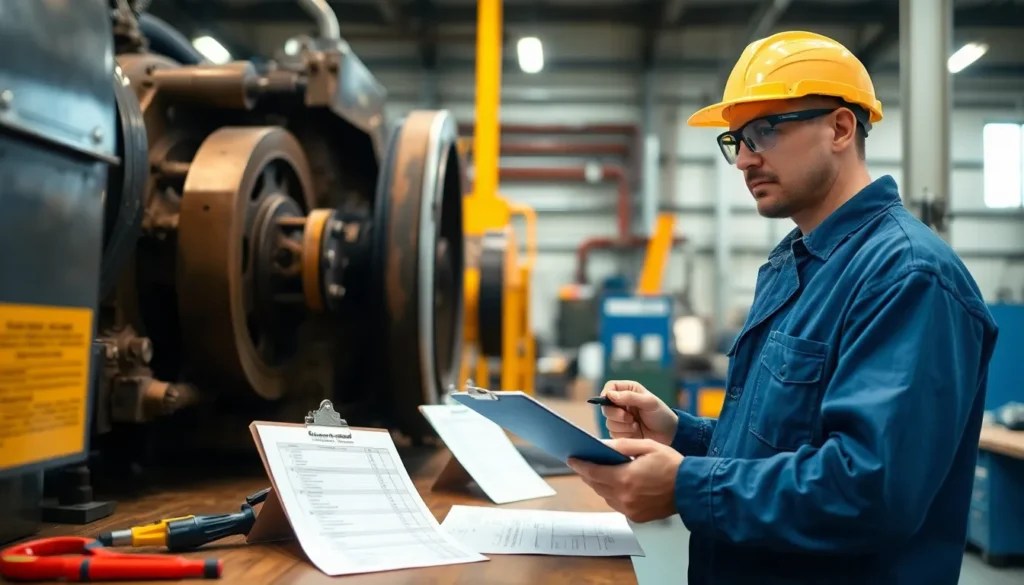In the world of equipment and machinery, ignoring preventive maintenance is like skipping leg day at the gym—eventually, it’ll catch up with you. Preventive maintenance checklists are the unsung heroes that keep everything running smoothly, saving time and money in the long run. Think of them as your trusty sidekick, ensuring that every nut and bolt is in its place while you focus on the bigger picture.
Table of Contents
ToggleImportance of Preventive Maintenance Checklists
Preventive maintenance checklists ensure systematic evaluations of equipment and machinery. These tools help identify issues before they escalate into significant problems. By following a checklist, teams can enhance reliability and longevity of assets. Regular use of checklists aids in compliance with safety regulations; neglecting this can lead to costly penalties.
Efficiency often improves with the implementation of well-structured checklists. Each completed task contributes to operational continuity, minimizing unexpected downtime. Prioritizing preventive measures can ultimately reduce long-term repair costs. Many organizations experience a decline in breakdown frequency after adopting checklists as standard practice.
Preventive maintenance checklists facilitate better communication among team members. They provide clarity on responsibilities and expectations, allowing for smoother workflow. When everyone understands their role in the maintenance process, collaboration increases, enhancing overall productivity.
Data shows that proactive maintenance extends the average lifespan of machinery by up to 30%. Using checklists aligns maintenance activities with organizational goals, ensuring all team efforts target specific outcomes. Checklists also serve as documentation for completed tasks, valuable for audits and regulatory reviews.
Incorporating preventive maintenance checklists into daily operations guarantees a more organized approach. They empower workers to track their progress, fostering accountability. Prioritizing these checklists lays the foundation for a culture of safety and reliability within the organization.
Types of Preventive Maintenance Checklists

Preventive maintenance checklists come in various forms tailored to different frequencies of operation. These checklists enhance the effectiveness of maintenance efforts, ensuring critical tasks align with organizational needs.
Daily Checklists
Daily checklists focus on essential tasks that ensure equipment operates efficiently every day. These checklists often include inspections of equipment for visible wear and tear, lubrication of moving parts, and verification of safety features. Addressing small issues daily helps prevent larger problems from developing. Examples of routine checks might encompass examining fluid levels and cleaning filters. Each task completed contributes to overall equipment reliability and extends its lifespan.
Weekly Checklists
Weekly checklists target maintenance tasks that require more in-depth evaluations but occur less frequently than daily checks. Tasks may involve thorough inspections of machinery, checking for unusual sounds, and calibrating equipment settings. Additionally, these checklists often integrate reviewing data from previous work orders. Gathering this information allows teams to identify patterns or recurring issues. Completing weekly tasks reinforces preventive measures and ensures operations run smoothly without unexpected disruptions.
Monthly Checklists
Monthly checklists encompass comprehensive evaluations crucial for long-term maintenance strategy. These evaluations may include replacing worn parts, conducting detailed system audits, and enforcing compliance regulations. Teams often review performance metrics collected over the month to monitor efficiency and identify areas for improvement. Regular maintenance actions taken at this interval significantly reduce downtime and operational costs. Ensuring completion of these tasks builds a proactive maintenance culture and supports organizational accountability.
Creating Effective Preventive Maintenance Checklists
Creating effective preventive maintenance checklists ensures that every aspect of equipment care is systematically addressed. These checklists enhance reliability and operational efficiency within organizations.
Identifying Key Tasks
Prioritizing essential tasks is crucial when creating checklists. Equipment operators must determine what is necessary for optimal functionality. Regular tasks may include inspections, lubrication, and parts replacements. Identifying tasks specific to each piece of equipment enhances the checklist’s relevance. Consider categorizing tasks by frequency to streamline operations. Daily tasks might focus on routine checks, while weekly and monthly tasks require more comprehensive evaluations. This strategic approach helps prevent major breakdowns and extends machinery lifespan significantly.
Involving Team Members
Engaging team members in the checklist creation process fosters collaboration and ownership. Workers possessing firsthand experience can provide valuable insights into equipment needs. Involving them builds a sense of responsibility for maintenance practices. Regularly reviewing checklists collectively ensures that updates reflect current operational realities. Implementing a feedback loop encourages continuous improvement in preventive maintenance processes. Team involvement also promotes accountability and enhances communication, linking accountability directly to improved productivity.
Best Practices for Using Preventive Maintenance Checklists
Utilizing preventive maintenance checklists effectively maximizes their benefits. Start by ensuring that checklists are detailed yet straightforward. Specific tasks within the checklists, such as inspections and parts replacements, help maintain equipment reliability.
Engaging team members during the checklist development process fosters ownership and accountability. Collaboration enhances the relevance of each checklist, reflecting current operational needs. Regularly reviewing and updating checklists keeps them aligned with changing procedures or equipment configurations.
Prioritize daily tasks to cover essential equipment operations. Addressing small issues promptly prevents larger complications from arising. Weekly evaluations allow for in-depth inspections and data analysis, revealing patterns that encourage proactive maintenance measures.
Conduct monthly assessments for comprehensive equipment evaluations. This approach includes replacing worn components and performing system audits, ensuring long-term effectiveness. Documenting completed checklist tasks supports compliance during audits and enhances organizational reliability.
Encourage a culture of continuous improvement within the team. Feedback on checklist usability and task completeness can lead to refinements, optimizing effectiveness. If employees feel empowered to suggest improvements, they contribute to enhanced productivity.
Leverage technology to streamline checklist usage. Digital tools can simplify tracking, updating, and reporting on maintenance tasks. Such advancements can help organizations maintain comprehensive records easily.
Consistency across all maintenance checklists promotes a structured approach to equipment care. Regularly following structured checklists strengthens overall operational efficiency and sustainability.
Preventive maintenance checklists are indispensable for maintaining equipment efficiency and reliability. By implementing these structured tools, organizations can proactively address potential issues before they escalate, ensuring smooth operations and reducing unexpected downtime.
Regular use of checklists not only enhances communication among team members but also fosters a culture of accountability and safety. As teams engage in the checklist process, they develop a deeper understanding of their responsibilities and the importance of maintenance.
Ultimately, the effective use of preventive maintenance checklists leads to significant cost savings, improved asset longevity, and compliance with safety regulations. Embracing this proactive approach is essential for any organization aiming to optimize its operational performance and achieve long-term success.










